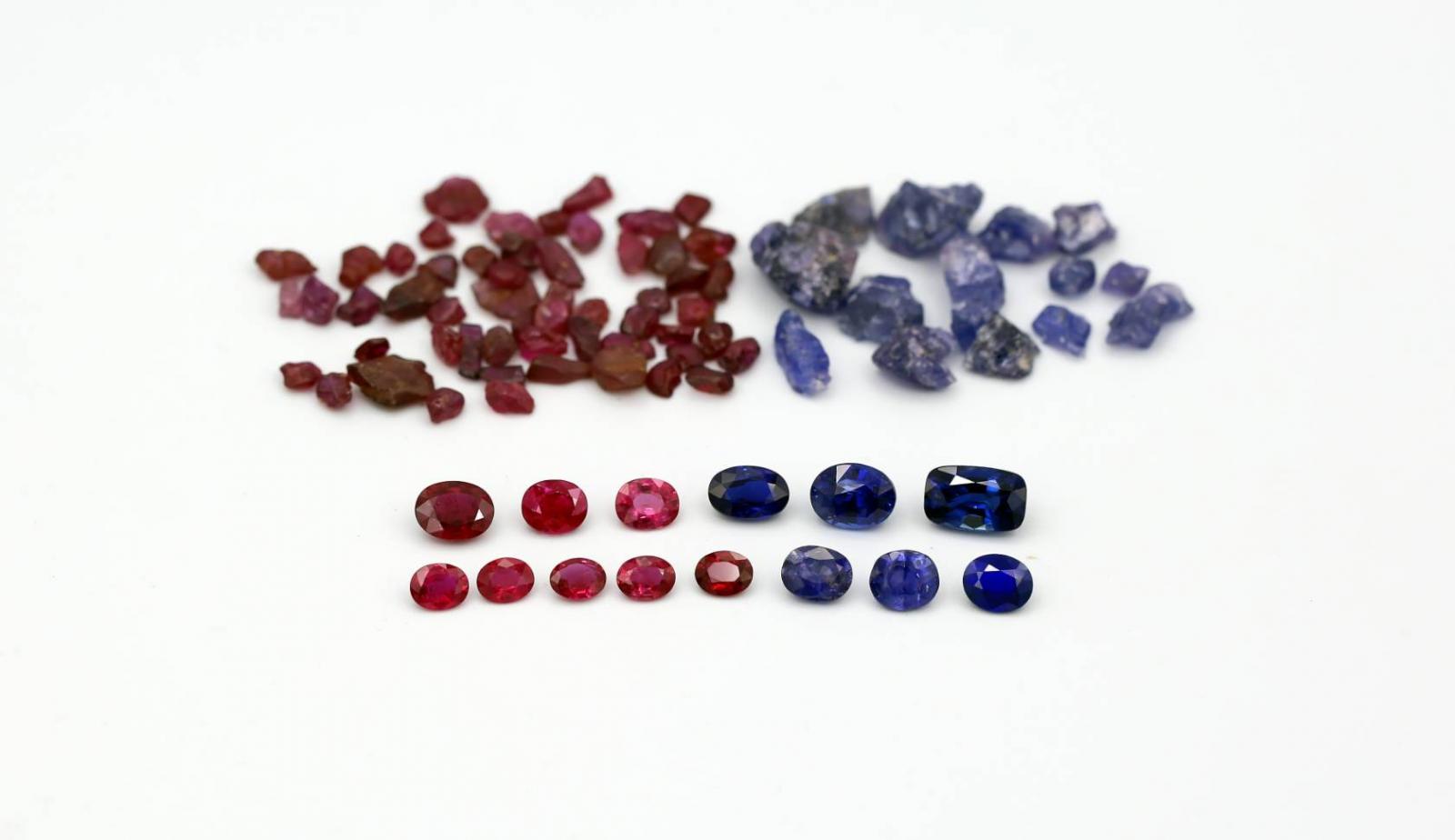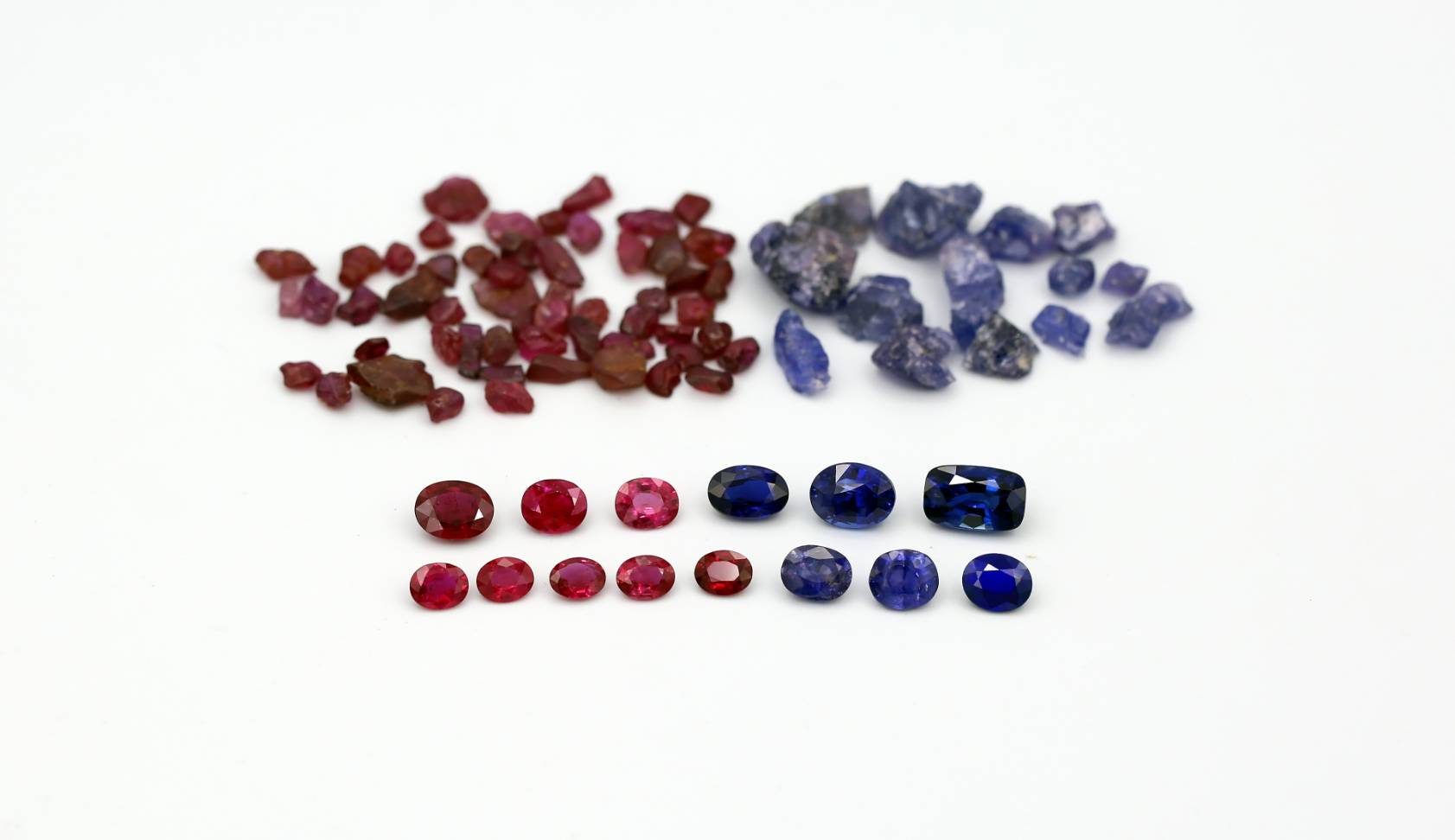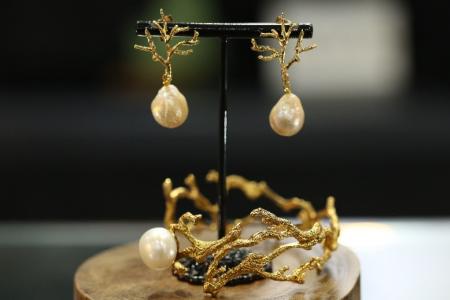
An Artificial Intelligence Approach to Build Smart Databases for Origin Determination of Ruby & Sapphire
An Artificial Intelligence Approach to Build Smart Databases for Origin Determination of Ruby and Sapphire
- Wanthanachaisaeng1, A Rungruengphol1., T. Sripoonjan2., W. Suwanmanee3., M. Seneewong Na Ayutthaya3., T. Lhuaamporn3., C. Jakkawanvibul3 and T. Leelawatanasuk3
1: College of Creative Industry, Srinakharinwirot University, Bangkok, Thailand
2: G-ID Laboratories, Bangkok, Thailand
3: The Gem and Jewelry Institute of Thailand (Public Organization), Bangkok, Thailand
Email: [email protected]

Fig. 1 Ruby and sapphire samples from various locations. Photo by W. Suwanmanee
Currently, the requirement of origin determination report for ruby and sapphire (Figure 1) is needed in the gem market because the gemstone origin is a significant factor in the stone valuation. Up to the present days, ruby and sapphire gem materials have been collectively sourcing from a large number of deposits around the world. It is thus becoming increasingly more difficult to distinguish the stone geographic origin because massive amounts of gem physical and chemical data from those deposits are often overlapping, and require more reliable approaches to sort them out and tackle this challenge. The reliable method for origin determination requires a large number amount of trustworthy database, which are relatively complicated, to separate one another and match the unknown.
The fact that gem ruby and sapphire deposits were formed under a wide variety of geologic condition and environment, for examples, marble-hosted metamorphic ruby deposits (e.g., Mogok & Mong Hsu, Myanmar; Luc Yen, Vietnam) related to Himalayan Orogeny ~ 65 Ma (Garnier et al.,2002, 2006, 2008; Nu, 2005: Long et al., 2004), metamorphic ruby deposits (e.g., Montepuez-Nampula, Mozambique; Longido, Tanzania) related to the Pan-African orogeny ~800-450 Ma, (Fanka and Sutthirat, 2018; Pardieu et al, 2009; Dirlam et al.,1992; Hughes et al., 2017), ruby (e.g., Thai-Cambodia border) associated with Cenozoic (< ~25 Ma) basaltic volcanism (Chualaowanich et al., 2005; Sutthirat et al., 2005, 2018; Promwongnam and Sutthirat, 2019a&b), low Fe sapphire in pegmatite (e.g., Kashmir, India; Mogok, Myanmar) related to Himalayan Orogeny ~ 65 Ma (Atkinson & Kothavala, 1983; Kane & Kammerling, 1992; Giuliani et al., 2007; Soonthorntantikul et al., 2021), low & high Fe metamorphic sapphire deposits (e.g., Umba & Tundulu, Tanzania) related to the Pan-African orogeny ~ 800 – 450 Ma (Hughes et al., 2017), low Fe metamorphic sapphire deposits (e.g., Ratanapura & Elahera, Sri Lanka) related to high grade granulite facies metamorphism ~650-550 Ma (Kroner, 1993), high Fe sapphire (e.g., Thailand, Vietnam, Australia) associated with Cenozoic (< ~ 25 Ma) basaltic volcanism (Khamloet et al., 2014; Promwongnam and Sutthirat, 2019b, Vu et al., 2020). As such ruby and sapphire from different geological origins may contain differing trace element contents, some of which are the cause of colour variance in these stones. At the present, the chemical composition of the stone, particularly the trace element contents that can be analyzed semi-quantitatively and quantitatively by Energy Dispersive X-ray Fluorescence (EDXRF) spectrophotometry, Electron Probe Micro Analyzer (EPMA), and Laser Ablation Inductively Coupled Plasma Mass Spectrometry (LA-ICP-MS) are the key to determine the stone origin. These data are generally plotted in 2D or 3D graphs by the various kinds of trace elements to illustrate the amount of grouping (Groat et al, 2019; Palke et al, 2019a; and Palke et al, 2019b). The trace elements from 2 or 3 kinds of each origins almost always show the overlap of data in the plots. For this reason, it is a complex process to determine the origin of the stone in the report (Figure 2).

Fig. 2 Systematic scheme for origin determination of gemstone utilized artificial intelligence.
In our approach, we have applied the Artificial Intelligence (AI) to classify the group of trace element and spectral data from the databases of the known ruby and sapphire origins. The trace element data were analyzed by EDXRF and the spectral data were collected by photoluminescence spectrometer, Raman spectrometer, UV-Vis-NIR spectrophotometer, and FTIR spectrometer. The database requires at minimum a certain number of samples to be able to represent the origin of the stone. Different machine learning algorithms are programs that can learn chemical composition and spectral data, and improve from experience without human interference. Various kinds of learning algorithm, K Nearest Neighbors (KNN), Random Forest, Support Vector Machine (SVM) and Artificial Neuron Networks (ANN) were deployed to examine every feasible aspect of potentials. Feature selection must be investigated by a gemologist to find the best condition for origin dataset separation. The quality of the features in the dataset can have a major impact on the determination of origin result. The suitable selection features which may have more than 3 datasets can be applied for the machine learning (Figure 2).
The algorithm and features were selected and used to create the computer program, “Gem Origin Determination (GOD)” by using the gemstone database to determine the origin of unknown sample. These data are arranged and categorized as prototypical factors to create machine learning methods using a basis of Artificial Intelligence software, as well as a computer programming language Python. The unknown sample data are imported to the GOD program to classify the set of data through machine learning to get the result of specific origin of the stone.
The output of this study is the database of trace element contents and the spectral data of rubies and sapphires that can be used on the GOD program to determine the origin of unknown stone. However, more data of each known gemstone origin are required to get more precise and powerful outcome.
For the origin determination by chemical composition, there was a slight discrepancy in some results due to the limitations of using semi-quantitative data by EDXRF. However, that shortcoming can be greatly alleviated with more numbers of samples in the database. Furthermore, quantitative chemical data by LA-ICP-MS can similarly make the result more precise and powerful.
Acknowledgment
This research was supported by Thailand Science Research and Innovation (TSRI). The authors are grateful to academic advisors Assoc. Prof. Dr. Visut Pisutha-Arnond, and Wilawan Atichat for their valuable comments and kind review of this article.
Reference
Atkinson, David and Kothavala, Rustam Z. Kashmir Sapphire, 1983. Gems and Gemology, Vol. 19(2), pp. 64-67
Chualaowanich, T., Sutthirat, C., Pisutha-Arnond, V. and Harzenberger, C. 2005. Another constrain on Thai-corundum genesis: new evidence from ruby-bearing xenoliths from the eastern gem field, Thailand. Proceedings of the International Conference on Geology, Geochronology and Mineral Resources of Indochina (GEOINDO 2005). Khon Kaen, Thailand, pp.345.
Dirlam, D.M., Misiorowski, E.B. et al.,1992. Gem wealth of Tanzania, Gems & Gemology, 28(2), pp. 80-102.
Fanka, A., Sutthirat,C., Petrochemistry, mineral chemistry, and pressure–temperature model of corundum-bearing amphibolite from Montepuez, Mozambique, Arabian Journal for Science and Engineering, Vol.43: pp.3751–3767
Garnier, V., Giuliani, G., Maluski, H., Ohnenstetter, D., Phan Trong, T., Hoàng Quang, V., Pham Van, L., Vu Van, T., Schwarz, D., 2002.Ar–Ar ages in phlogopites from marblehosted ruby deposits in Northern Vietnam: evidence for Cenozoic ruby formation. Chemical Geolog,y Vol.188, pp.33–49
Garnier, V., Maluski, H., Giuliani, G., Ohnenstetter, D., Schwarz, D., 2006. Ar–Ar and U–Pb ages of marble-hosted ruby deposits from Central and South-east Asia. Canadian Journal of Earth Sciences 43, pp.509–532.
Garnier, V., Giuliani, G., Ohnenstetter, D., Fallick, A.E., Dubessy, J., Banks, D., Vinh, H.Q., Lhomme, T., Maluski, H., Pêcher, A., Bakhsh, K.A., Long, P.V., Trinh, P.T., Schwarz, D., 2008. Marble-hosted ruby deposits from Central and Southeast Asia: Towards a new genetic model. Ore Geology Reviews 34, pp.169–191
Giuliani, G., Ohnenstetter, D., Garnier, V., Fallick, A.E., Rakotondrazafy, M., Schwartz, D., 2007. The Geology and genesis of gem corundum deposits, Miner. Assoc. of Canada short Course 37, Yellowknife, NW Territories, pp. 23-78.
Groat, L. A., Giuliani, G., Stone-Sundberg, J., Sun, Z., Renfro, N. D., and Palke, A., 2019. A review of analytical methods used in geographic origin determination of gemstones. Gem and Gemology, Vol. 55 (4), pp. 512 – 535.
Gubelin Gem Lab. 2020. Gemtelligence. Source: https://www.gubelingemlab.com/ en/news/detail/gemtelligence [ 05 January 2021]
Hughes, R.W., Manorotkul, W. and Hughes, E.B, 2017. Ruby & Sapphire: a gemologist’s guide, RWH Publishing/ Lotus Publishing, 733 pp
Kane,R.E., Kammerling,R.C.1992. Status of ruby and sapphire mining in the Mogok Stone Tract, Gems & Gemology, Vol. 28 (3), pp.152-174.
Khamloet, p., Pisutha-Arnond, V., Sutthirat, C., 2014. Mineral inclusions in basaltic sapphires from Bo Phloi deposit, Kanchanaburi Thailand: indication of their genesis, Russian Geol. & Geophy., V. 25.
Kröner, A., 1991. African linkage of Precambrian Sri Lanka. Geologische Rundschau, Vol. 80 (2), pp. 429–440, http://dx.doi.org/10.1007/BF01829375.
Kröner, A., Williams. I.S.,1993. Age of metamorphism in the high-grade rocks of Sri Lanka. Jour. of Geol., Vol. 101, No. 4,pp. 513–521, http://dx.doi.org/10.1086/648243
Long, P.V., Giuliani, et al., 2004. Gemstones of Vietnam: A review, Australian Gemmologists, 22(4), pp. 162-168
Nu, T.T., 2005. A comparative study of the origin of ruby and sapphire in the Mogok, Pyinon and Mong Hsu areas. “Gem-Materials and Modern Analytical Methods” Proceedings of the International Symposium, Hanoi, September 26-October 2,
Palke, A. C., Saeseaw, S., Renfro, N. D., Sun, Z., and McClure, S. F., 2019a. Geographic origin determination of blue sapphire. Gems and Gemology, Vol. 55 (4), pp. 536 – 579.
Palke, A. C., Saeseaw, S., Renfro, N. D., Sun, Z., and McClure, S. F., 2019b. Geographic origin determination of ruby. Gems and Gemology, Vol. 55 (4), pp. 580 – 613.
Pardieu, V., Jacquat, S. et al, 2009. Expedition report to the ruby mining site in northern Mozambique (Niassa and Cabo Delgado Provinces), GIA Laboratory Report, Bangkok, 23 Dec., 46pp.
Promwongnam, S., Sutthirat, C., 2019a. An update on mineral inclusions and their composition in ruby from the Bo Rai gem field in Trat orovince, eastern Thailand. Journal of Gemmology, Vol. 36, (7), pp. 634-645
Promwongnam, S., Sutthirat, C., 2019b. Mineral inclusions in ruby and sapphire from the Bo Welu gem deposit in Chanthaburi, Thailand. Gems and Gemology, Vol. 55 (3), pp. 354 – 369
Sutthirat, C., Hauzenberger, C.3 Chualaowanich, T., Pisutha-Arnond, V., 2005. Ruby- bearing xenoliths in Trat basalt exposed In the vicinity of Bo Rai gem deposits, eastern Thailand, “Gem-Materials and Modern Analytical Methods” Proceedings of the International Symposium, Hanoi, September 26-October 2
Soonthorntantikul, W., Atikamsakul, U., Vertriest, W., 2021, Blue sapphires from Mogok, Myanmar: a gemological review. Gems and Gemology, Vol. 57 (4), pp. 292 – 317
Sutthirat, C., Hauzenberger, C., Chualaowanich, T., Assawincharoenkija, T., 2018. Mantle and deep crustal xenoliths in basalts from the Bo Rai ruby deposit, eastern Thailand: Original source of basaltic ruby, Journal of Asian Earth Sciences, 164, pp. 366–379
Vu, D.T.A., Salam, A., Fanka, A., Belousova, E., Sutthirat, C., 2020. Mineral inclusions in sapphire from basaltic terranes in southern Vietnam: Indicator of formation model. Gems and Gemology, Vol. 56 (4), pp. 498 – 515



